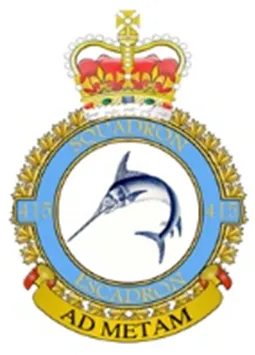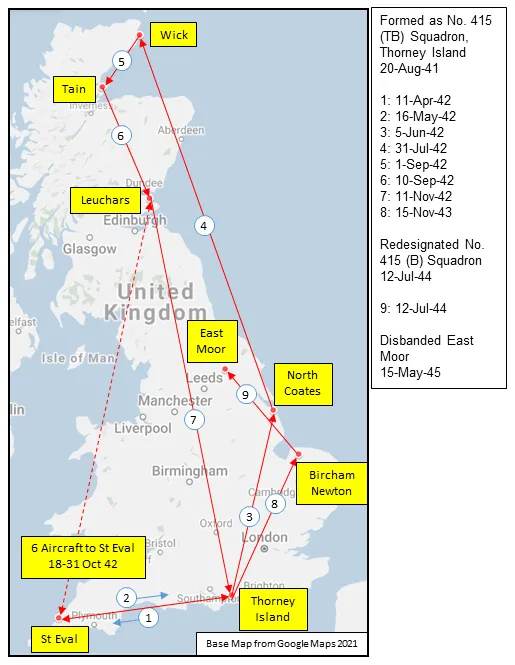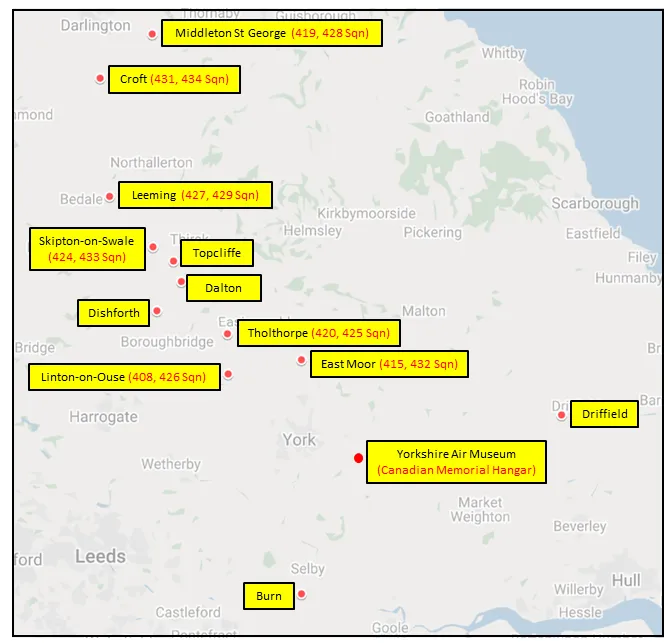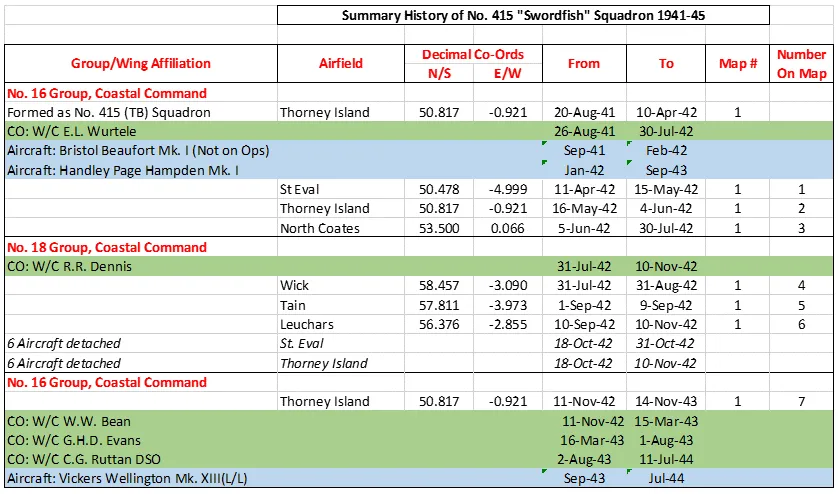Forbes, F M
Survived 1944-11-02


Birth Date: unkown date
Born:
Home:
Enlistment:
Enlistment Date: Unknown
Service
RCAF
Unit
415 (B) Sqn- Squadron
Ad Metam To the mark
Base
East Moor
Rank
Flying Officer
Position
Flying Officer
Service Numbers
J/86509
Target
 Dusseldorf Germany
Dusseldorf Germany
415 Swordfish Squadron (Ad Metam) RAF East Moor. Halifax BIII MZ 882 6U-C was attacked by a night fighter just after releasing it's bombs, wounding the flight engineer. Despite a fire in the rear turret both gunners fought back and made hits on the night-fighter, claiming it destroyed. The fire was extinguished, but damage to the hydraulics left the bomb bay doors open and the flaps down. The crew had to assist in moving the damaged elevators, but the aircraft managed to return to England and an emergency airfield at RAF Woodbridge, Suffolk, England
Pilot, Flying Officer FM Forbes (RCAF), Navigator, Pilot Officer JM Fernie (RCAF), Bomb Aimer, FS SE Morris (RCAF), Wireless Operator, Warrant Officer Class 2 VA Witteralli (RCAF), Mid/Upper Air Gunner, FS JC Scarf (RCAF), Rear Air Gunner, Sergeant TM Robertson DFM (RCAF) and Flight Engineer, Sergeant RA Afford (RAFVR), survived safe
The bomber was deemed beyond repair (R. Koval)
There were three 415 Squadron Halifax aircraft lost on this operation. Please see Knobovitch, H for information on Halifax MZ 603 6U-E and Morton, MR for information on Halifax NA 583 6U-F
Halifax MZ882
Handley Page Halifax

The Handley Page Halifax is a British Royal Air Force (RAF) four-engined heavy bomber of the Second World War. It was developed by Handley Page to the same specification as the contemporary twin-engine Avro Manchester.
The Halifax has its origins in the twin-engine HP56 proposal of the late 1930s, produced in response to the British Air Ministry's Specification P.13/36 for a capable medium bomber for "world-wide use." The HP56 was ordered as a backup to the Avro 679, both aircraft being designed to use the underperforming Rolls-Royce Vulture engine. The Handley Page design was altered at the Ministry to a four-engine arrangement powered by the Rolls-Royce Merlin engine; the rival Avro 679 was produced as the twin-engine Avro Manchester which, while regarded as unsuccessful mainly due to the Vulture engine, was a direct predecessor of the famed Avro Lancaster. Both the Lancaster and the Halifax would emerge as capable four-engined strategic bombers, thousands of which would be built and operated by the RAF and several other services during the War.
On 25 October 1939, the Halifax performed its maiden flight, and it entered service with the RAF on 13 November 1940. It quickly became a major component of Bomber Command, performing routine strategic bombing missions against the Axis Powers, many of them at night. Arthur Harris, the Air Officer Commanding-in-Chief of Bomber Command, described the Halifax as inferior to the rival Lancaster (in part due to its smaller payload) though this opinion was not shared by many of the crews that flew it, particularly for the MkIII variant. Nevertheless, production of the Halifax continued until April 1945. During their service with Bomber Command, Halifaxes flew a total of 82,773 operations and dropped 224,207 tons of bombs, while 1,833 aircraft were lost. The Halifax was also flown in large numbers by other Allied and Commonwealth nations, such as the Royal Canadian Air Force (RCAF), Royal Australian Air Force (RAAF), Free French Air Force and Polish forces.Wikipedia
 National Air Force Museum of Canada
National Air Force Museum of Canada
415 (B) Sqn Ad Metam ("Swordfish")
History of the Squadron during World War II (Aircraft: Beaufort I, Hampden I, Wellington XIII, Albacore I, Halifax III & VII)

The squadron was the 13th RCAF squadron formed overseas, at Thorney Island, Hampshire, England on August 20, 1941. It was a originally a torpedo bomber squadron, briefly flying Bristol Beaufort Mk 1 (but not operationally) before transferring to Handley Page Hampden aircraft, with the squadron letters GX. The squadron flew from a number of bases as part of Coastal Command Nos 16 and 19 Groups. Over the course of 1942, these bases ranged from the south of England (St. Eval, Cornwall) to the north of Scotland (Wick, Caithness). In November 1942, it settled at Thorney Island for a year before moving to Bircham Newton, Norfolk, in November 1943. From September and October 1943, the squadron flew Wellington Mk. XIII and Fairey Albacore Mk. I, the latter having the squadron code of NH. The squadron was active on D-Day, laying smoke screens for the Allied shipping. After D-Day, there was less need for maritime operations, and the squadron was designated 415(B), was equipped with Handley-Page Halifax III and VII aircraft, and joined 6 Group (RCAF) of Bomber Command, flying from East Moor, Yorkshire (RCAF No 62 Base),where it remained until the end of hostilities. Its squadron code was changed to 6U [this is according to Moyes and Wikipedia, but Kostenuk gives "GU", which may be a misprint]. Its last mission was on April 25, 1945. The squadron was disbanded at East Moor on May 15, 1945.
In the course of the war, the squadron flew 1645 torpedo bomber operations for a cost of 33 aircraft, and was credited with 5 ships sunk, with 2 damaged and 2 others shared. In its bomber role, 1608 sorties were flown for the loss of 22 aircraft, dropping 5041 tons of bombs and 798 tons of incendiaries. The crews were awarded 1 DSO, 86 DFC's and 1 Bar to DFC, 1 GM and 9 DFM's. Battle Honours were: Atlantic 1942, English Channel and North Sea 1942-44, France and Germany 1944-45 Biscay Ports 1944, Ruhr 1944-45, German Ports 1944-45, Normandy 1944, Rhine, Biscay 1942-43.Wikipedia, Kostenuk and Griffin
Squadron History (Bomber Command Museum PDF)
Maps for Movements of 415 Squadron 1941-45
 MAP 1: 415 Squadron Movements Dec 1941-Aug-42 (right-click on image to display enlarged in new tab) |  MAP 2: 6 Group Bomber Bases 1943-45 |
415 Squadron History Summary 1941-45

415 Squadron History Summary 1941-45 Page 2

History of the Squadron Post-WWII (Aircraft: Argus, Aurora)
The squadron was re-established as a Maritime Patrol squadron on 1 June 1961 at RCAF Station Summerside, Prince Edward Island , and equipped with the Canadair CP-107 Argus. The Squadron was quick to establish a Canadian endurance record on 26 July 1961, flying 30 hours and 20 minutes, non-stop. During its two decades at Summerside, the Swordfish squadron conducted a variety of missions including anti-submarine, fisheries and pollution, and Northern sovereignty patrols, operating from an ever-increasing number of deployment locations. In 1964, the Squadron assumed the Search and Rescue duties for the Maritime Air Command. In 1981, all the Maritime Patrol Squadrons converted to the Lockheed CP-140 Aurora aircraft and all the East Coast CP-140 squadrons were consolidated at Canadian Forces Base (CFB) Greenwood . On the afternoon of 24 July 1981, Argus 736, call sign "Sidney 02", conducted a fly-past for a ceremonial parade to celebrate 415 Squadron’s welcome to Greenwood; its Change of Command ceremony, and, the last official Canadian Forces flight of the Argus. In 1982, the Squadron received its Standard in recognition of 25 years of dedicated service to the Crown and the people of Canada.
Operationally, Iraq’s invasion of Kuwait in 1990 prompted Canada to send a naval task group to enforce the United Nations’ resolutions. 415 Squadron was tasked to support this task group during its work-up phase during transit from Halifax to the Mediterranean Sea. The Aurora exercised the self-defense capability of the Canadian Task Group and provided surface surveillance. In 1993, Operation SHARP GUARD brought crews from 415 Squadron to Sigonella, Sicily, where they flew surveillance patrols in the Adriatic in support of the United Nation’s arms embargo of the Former Republic of Yugoslavia. The Squadron later participated in Operation ASSISTANCE, providing humanitarian assistance to the people of Manitoba during the great flood of 1997. Throughout the 80s and 90s, anti-submarine warfare training and anti-submarine patrols remained the focal point for 415 Squadron. With the end of the Cold War and new asymmetric threats emerging, the Aurora fleet became more involved in overland missions; to align the CP140 fleet with this new reality, all the CP140 squadrons were rebranded as Long Range Patrol (LRP) Squadrons. 415, along with the other LRP Squadrons, were active participants in Operation APOLLO, deploying crews to the Arabian Sea region in support of the American-led Campaign Against Terrorism (CAT) following the events of September 11, 2001. The first two crews rotated through on deployments of six months duration. For the remainder of the operation, crews were rotated every 56 days. The CP-140 commitment to Operation APOLLO ended in July 2003.
As a follow-on to Operation APOLLO, the LRP fleet, under the direction of 1 Canadian Air Division Headquarters, developed a Squadron Vanguard posture for future potential missions. 415 Squadron was the first unit selected, holding Vanguard from 1 April to 30 September 2004, maintaining a high readiness to rapidly deploy worldwide. In September 2004, coincident with the close of 415 Squadron’s Vanguard liability period, came the call to support NATO naval units in the Mediterranean conducting Operation ACTIVE ENDEAVOUR, with the mission to deter, monitor and intercept potential threats of terrorism in the Mediterranean Sea; to defend NATO member nations against terrorists operating at sea; and, to demonstrate resolve and presence in the campaign against terrorism. By mid-October, one crew and support staff from 415 Squadron along with 14 and 19 Wing (Comox) technicians and aircrew, were in theatre and flying Operation SIRIUS missions out of Sigonella. Soon thereafter, on 29 July 2005, 415 Squadron was stood down for a second time.
In 2015, it was decided to merge the capabilities and expertise of 14 SES and MPEU into a single unit that would optimize frontline operator and engineering input into the ongoing development of the platform, and the associated mission/training support systems. This would allow for a more efficient, holistic approach to deal with the software/hardware complexities and to fully realise the vast potential of the AIMP-upgraded Aurora, now dubbed the CP140M. As such, after a 10-year absence, 415 Squadron and the Swordfish were stood up to once again proudly serve the government and people of Canada.
 Library and Archives Canada Service Files (may not exist)
Library and Archives Canada Service Files (may not exist)
 Halifax Heavy Bomber WWII
Halifax Heavy Bomber WWII Harold A Skaarup Web Page
Harold A Skaarup Web Page Wikipedia Halifax Bomber
Wikipedia Halifax Bomber